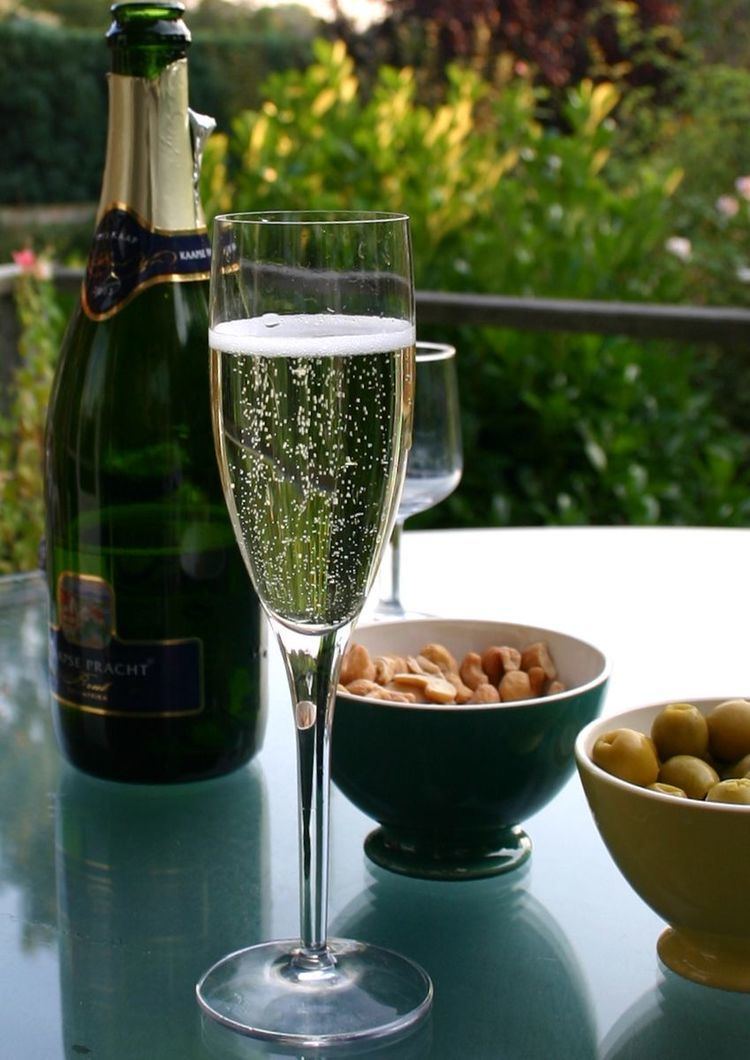 | ||
Champagne stemware refers to the flute and coupe glasses used in the consumption of champagne, other sparkling wines, and certain beers. As with other stemware, the stem allows the drinker to hold the glass without affecting the temperature of the drink.
Contents
Champagne flute
The champagne flute (French: flûte à champagne) is a stem glass with a tall, narrow bowl, generally holding about 6 to 10 US fl oz (180 to 300 ml) of liquid.
The champagne flute was developed along with other wine stemware in the early 1700s as the preferred drinking vessel for wine shifted from metal and ceramic to glassware. Initially, the flute was tall, conical, and slender. By the 20th century, however, the shape preferred by glassware purchasers had changed from a straight-sided glass to one which curved inward slightly near the lip.
The bowl is designed to retain champagne's signature carbonation by reducing the surface area at the opening of the bowl. Nucleation in a champagne glass helps form the bubbles seen in champagne. Too much nucleation will cause the carbonation to fizzle out quickly. A smoother surface area will produce fewer bubbles in the glass and thus more bubble texture in the taster's mouth. Flutes, with their deep bowl, allow for greater visual effect of bubbles rising through the liquid to the top. The flute also helps regulate and reduce the oxygen-to-wine ratio, which both enhances the aroma of the wine as well as the taste.
While most commonly used for sparkling wines, flutes are also used for certain beers, especially fruit beers and Belgian lambics and gueuzes. The flute shows off the beer's color, and helps gather the aroma for the nose. The champagne flute is distinguished from the pilsner glass, which lacks a stem.
Champagne coupe
The champagne coupe is a shallow, broad-bowled, saucer shaped stemmed glass generally capable of containing 4 to 8 US fl oz (120 to 240 ml) of liquid. Legend has it the shape of the coupe was modelled on the breast of Marie Antoinette, but the glass was designed especially for sparkling wine and champagne in England in 1663. The coupe was fashionable in France from its introduction in the 1700s until the 1970s, and in the United States from the 1930s to the 1980s.
White wine tulip glass
Champagne is a white wine, and may be served in a tulip glass. The tulip glass is distinguishable from the champagne flute in that the body is flared wider and the mouth is wider. Some oenophiles prefer the tulip glass, as it permits the drinker to get more of the aroma than a traditional flute while the mouth is still narrow enough to avoid quick loss of carbonation, with the glass maker Riedel particularly criticizing flutes.
Innovations
In the 1960s, double-wall stemware was developed for champagnes as well as other beverages. The glass contains an inner and outer wall separated by a small gap filled with air. This gap slows the transfer of heat from the drinker's hand to the champagne.
